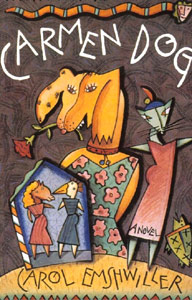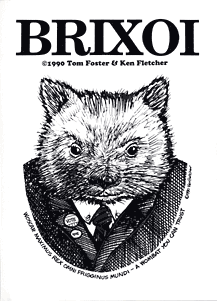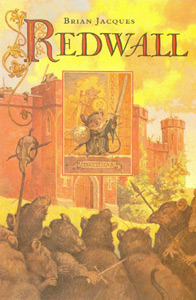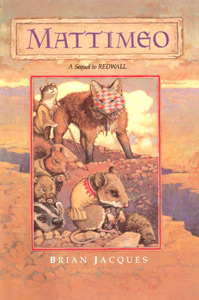
The Yarf! reviews by Fred Patten
Note: This is a fraction of the entire listing. If you’re on broadband, you might want to try the high speed version instead.

The Yarf! reviews by Fred Patten
Note: This is a fraction of the entire listing. If you’re on broadband, you might want to try the high speed version instead.
Welcome to the “Patten’s reviews” wing of the Anthro Library! Since this is a collection of columns from a dormant (if not dead) furzine called YARF!, a word of explanation might be helpful: In its day, YARF! (aka ‘The Journal of Applied Anthropomorphics’) was perhaps the best-known—and best in quality—of furry zines. Started in 1990 by Jeff Ferris, YARF!’s roster of contributors reads like a Who’s Who of furdom in the last decade of the 20th Century. In any issue, the zine’s readers could expect to enjoy work by the likes of Monika Livingstone, Watts Martin, Ken Pick, and Terrie Smith; furry comic strips such as Mark Stanley’s Freefall… and Fred Patten’s reviews of furry books and comics.
Unfortunately, YARF! has been thoroughly inactive since its 69th issue, which was released in September 2003. We can’t say whether YARF! will ever rise again… but at least we can prevent its reviews from falling into disremembered oblivion. And so, with the active cooperation of Mr. Patten, Anthro is proud to present Mr. Patten’s review columns—including the final one, which would have appeared in the never-printed YARF! #70.
Full disclosure: For each reviewed item, we’ve provided links you can use to check which of four different online booksellers—Amazon.com
, Barnes & Noble
, Alibris
, and Powell’s Bookstore—now has it in stock. Presuming the item in question is available, if you buy it Anthro gets a small percentage of the price.
 #5 / Jul 1990 |
||||
|
|
|
|||
|
|
|
|||
|
|
|
|||
 |
||
| Title: | Carmen Dog | |
| Author: | Carol Emshwiller | |
| Publisher: |
Mercury House (San Francisco), Mar 1990 |
|
| ISBN: | 0-916505-70-2 | |
| Hardcover, 161 pages, $15.95 | ||
| Availability: | Am |
|
|
|
||
| ISBN: | 0-916505-77-X | |
|
Trade paperback, $9.95 |
||
| Availability: | Am |
|
Mercury House is strongly promoting this as “a feminist Animal Farm.” It is certainly feminist, but I see closer stylistic parallels with Pinocchio
and with the classic Italian comic operas. The characters are deliberately histrionic; they posture exaggeratedly; the action takes place in a few locales that are described in the manner of artistically-stylized stage sets. There is the imagery everywhere of opera and of haiku; two very intellectual art forms. Carmen Dog is totally different in mood from the dramatic adventure narrative of Animal Farm.
Females are changing throughout the world. Female animals are evolving into humans; female humans are devolving into animals. Pooch is a pedigreed golden setter who is the devoted pet of an upper-class couple, from whom she has picked up a passion for opera. Pooch finds herself taking on more and more of the household wifely chores, including minding the baby, as her mistress degenerates into a nasty snapping turtle. One day when the master is on a business trip, the mistress becomes too dangerous to stay around. Pooch flees with the baby into the streets of New York City.
The world’s men are extremely annoyed. They are sure the females are doing this just to be contrary, to upset the natural order of male dominance. A doctor gets a government grant to perform electroshock research on the womanized animals. Among those caught and delivered to him are Pooch and the baby. (Pooch had managed to see a performance of Carmen before her capture and is now calling herself Pucci; she dreams of becoming an opera star.) The doctor shocks everyone, including the baby. His assistant is his dumpy wife, Rosemary, who seems kindly but is too passive to restrain him. (Besides, a good wife does not contradict her husband.)
Pucci and the other animal-women escape. She hopes to find refuge with an operatic impresario, Valdoviccini, but he is, alas, more interested in her for reasons of lust than for her talent. The government decides that women are more trouble than they are worth. It constructs an Academy of Motherhood on Fifty-seventh Street:
It looks rather like a fortress; indeed, it is a fortress, for no one wants motherhood defenseless in the modern world, or at the mercy of primitive forces. Major stumbling blocks are the mothers themselves. (Perhaps in the future a small monetary reward for mothering might not be out of line.) It is hoped that, under the aegis of the Academy of Sciences, motherhood will be modernized and mechanized and become a true science. (pg. 110)
Meanwhile, the animal-women are being gathered into a secret sisterhood, whose leader is none other than Rosemary. To keep the police from seizing Rosemary, many of the animal-women disguise themselves in Rosemary rubber-masks and frumpy housecoats. The police disguise themselves as Rosemarys to infiltrate the feminist movement. Rosemary advises the women to disguise themselves as policemen to infiltrate the military-industrial leadership. Soon New York is filled with badly-disguised Rosemarys and policemen rushing about. There is more, but it all ends in a grand climax in which everyone realizes that mankind and womankind should live in harmony as equals – “Neither Conqueror nor Conquered; Neither Victory nor Defeat”, as Pooch titles the grand aria in the opera she writes to commemorate the birth of this new world.
Carmen Dog is full of animal-women in various stages of hybridization: Chloe, the sexy Siamese cat woman; Mary Ann, the awkward duck(?)/swan(?) woman; Isabel, the murderous wolverine woman; and more. This is a different and a clever novel, but it may be too self-consciously literary and affected for the tastes of the average Furry fan. ![]()
 |
||
| Title: | BRIXOI | |
| Author: | Tom Foster & Ken Fletcher | |
| Publisher: |
Neo-Zagatine Press, Apr 1990 |
|
| ISBN: | — | |
|
100 pages. $10.00 (incl. postage & handling) |
||
| Availability: | Am / BN / Al / Pw | |
2007 editor’s note: In its initial 1990 appearance, this review contained information on where to order BRIXOI from. Since this information is no longer accurate or relevant, it has been deleted from the current presentation.
BRIXOI is a Neo-Zagatine publication of exactly 100 81/2" x 11" pages, issued simultaneously by Ken Fletcher in Minneapolis and by Tom Foster in Memphis. Ken Fletcher and Tom Foster have been drawing funny animals for years in fanzines, and this is a sampler of their work. Some pages are drawn by Ken Fletcher. Some are drawn by Tom Foster. Some are drawn by both Tom Foster and Ken Fletcher. A lot of the art is brand new, while other pages are reprints of old fanzine covers, personal Christmas cards, convention flyers, and the like, going back to 1982 or 1971 or whenever. (The copyright date on page 31 is 30,000 B.C.)
The book? fanzine? folio? is divided into four sections: The Art of Getting Around; The Cartoon Artist; In Search of Frogsworth; and Miscellaneous Row. But there is no real continuity. BRIXOI is just a collection of (presumably) what Foster & Fletcher consider to be some of their best fanzine funny-animal drawing of the past couple of decades. Sober and drunken funny animals. Funny animals flying spaceships and driving Model Ts. Funny animals playing the piano or washing dishes. Funny animal carpenters and sheriffs and bag ladies and politicians and soldiers and mythological deities. 100 pages of funny animals. An inside-back-cover Afterword refers to this as “the first book of BRIXOI”, so maybe there are more coming. I can certainly remember some great funny animal drawings by Fletcher and/or Foster over the past twenty years that are not in this volume, so there is room for more. ![]()
 |
||
| Title: | Normal u.s.a.—chili maneuvers | |
| Author: | Michael Jantze | |
| Publisher: |
Harvest Moon (Los Angeles), 1988 |
|
| ISBN: | — | |
|
200 pages, $7.50 + shipping & sales tax |
||
| Availability: | Am |
|
2007 note: In its initial 1990 appearance, this review contained information on where to order Normal u.s.a. from; since the book is on the author’s website for all to browse freely, that information has been deleted from the current presentation.
Do newspaper comic strips such as Berke Breathed’s Bloom County with a mixed human/anthropomorphic cast qualify for inclusion in an ‘Anthro Alert’ column? If you’re willing to stretch a point, you might want to read Normal u.s.a.—chili maneuvers, by Mike Jantze; Los Angeles, Harvest Moon, 1988. Normal began as a comic strip in the Cal State Northridge Daily Sundial in the mid-’80s, but this is a collection of new, unpublished strips that continue the lives and misadventures of his characters after Jantze graduated and the college paper dropped the strip. (It is part of an as-yet-unsuccessful development of Normal u.s.a. as a regular comic strip that Jantze is submitting to the newspaper syndicates.)
Normal u.s.a. has a mostly human cast, but there are a few delightful fantasy-animal characters, notably A. C., the beer-drinking armadillo whose relationship to the protagonists, Norm and Lynn, is halfway between a pet and a self-invited permanent house guest. (He cooks up a mean pot of chili.) ![]()
 #6 / Aug 1990 |
||||
|
|
|
|||
|
|
|
|||
|
|
|
|||
The Redwall Trilogy, by Brian Jacques. Illustrated by Gary Chalk.
 Cover of the Philomel Books edition |
||||
| Title: | Redwall | |||
| Publisher: | Philomel Books (New York), Mar 1987 | |||
| ISBN: | 0-399-21424-0 | |||
| Hardcover, 351 pages, $15.95 | ||||
| Availability: | Am |
|||
|
|
||||
| Publisher: | Avon Books (New York), Mar 1990 | |||
| ISBN: | 0-380-70827-2 | |||
| Paperback, 351 pages, $4.50 | ||||
| Availability: | Am |
|||
|
|
||||
 |
||||
|
|
||||
| Title: | Mossflower | |||
| Publisher: | Philomel Books (New York), Sep 1988 | |||
| ISBN: | 0-399-21549-2 | |||
| Hardcover, 431 pages, $16.95 | ||||
| Availability: | Am |
|||
|
|
||||
 |
||||
|
|
||||
| Title: | Mattimeo | |||
| Publisher: | Philomel Books (New York), May 1990 | |||
| ISBN: | 0-399-21741-X | |||
| Hardcover, 448 pages, $16.95 | ||||
| Availability: | Am |
|||
The Redwall novels teeter between a juvenile and adult readership. The original British editions are published by Hutchinson Children’s Books, Ltd., but the U.S. paperback edition by Avon Books is packaged as an adult literary fantasy “in the glorious tradition of Watership Down”. The final novel has just appeared in hardcover, and the first has just been reissued in an ‘inexpensive’ mass-market edition.
The trilogy is actually closer to an anthropomorphized version of Tolkien. Jacques’ world does not have magic, but his animal characters wear clothing, build their own houses and castles, and fight with their own swords and crossbows. Like Tolkien’s Hobbits, Jacques’ protagonists are peaceful yeomen (mice, moles, squirrels, rabbits, badgers) whose community is menaced by an army of carnivorous conquerors (weasels, rats, stoats, foxes) led by a truly evil commander. The woodland community must train itself to fight for its survival. One among them stands out as a warrior, and he must go on a dangerous quest while his mates try to hold the invaders back until he can return with aid.
Redwall is the story of the castle-like monastery of that name, an abbey in the forested land of Mossflower. Matthias is a young mouse in training to enter its Order of healers and scholars. However, he is more fascinated by the legend of Martin the Warrior, the brave mouse who drove away Mossflower’s enemies generations ago. When Mossflower is invaded anew by the hordes of Cluny the Scourge, a rat who combines the attributes of Attila the Hun and Genghis Khan, Matthias proves to have the skills of leadership to rally a resistance against them. But Matthias is convinced that he must obtain Martin’s long-missing sword before he can be a true warrior, so he leaves on a long quest to find it, while his friends grimly defend Redwall Abbey during the increasingly desperate siege.
Mossflower is Martin’s story. It is basically Redwall with the details reversed. Martin is a young Northern barbarian mouse who wanders into Mossflower, an animal community that had been conquered a generation earlier by the wildcat Verdauga and his mustelid ruffians. Verdauga has just been succeeded by his sadistic daughter Tsarmina, who is so murderous that she provokes the sullen Mosslanders into open revolt. Where Redwall was about vicious predators attacking the peaceful animals in their abbey, Mossflower is about the peaceful animals escaping into the woods and forming a Robin Hood-style peasant army to besiege the villains in their dark castle of Kotir. But the peasants fare badly against Tsarmina’s trained fighters, so Martin and two companions leave on a quest to find the legendary badger warrior, Boar the Fighter, and enlist his aid. Again the novel splits into two parallel stories, that of the heroic questors and that of the woodland animals battling to save themselves and their home.
Mattimeo features three parallel stories. Slagar the Cruel, a fox injured in the battles of Redwall, returns about a dozen mouse-years later for revenge. He kidnaps the community’s children, including Matthias’ son Mattimeo, and takes them to be sold into slavery to he rats of the underground kingdom of Malkariss. Matthias leads a rescue party after the slavers. It has barely left Redwall when the abbey is attacked by an army of crows, magpies and rooks led by General Ironbeak. The novel shifts back and forth between the hardship of young Mattimeo and his playmates as they are dragged towards the evil rats’ kingdom; the adventures of Matthias and his warriors as they race to overtake the slave caravan; and the battles inside Redwall as its woodland defenders are forced down floor by floor into the cellars.
The three Redwall novels bring to mind another comparison; the classical theatrical animated cartoon series such as the Road Runner and the Coyote, or Tom & Jerry
. The first one is delightful, but watching three or more at the same time makes it overly obvious to what extent they are similar to each other. All three novels have the same types of characters who react in the same ways. All three involve an ancient prophecy that must be unriddled. All three have stylistic repetitions that, taken together, seem too unimaginative. Jacques’ novels were originally published a year or more apart, but now they are all available together. You will probably enjoy any one of them, but it may be a mistake to read all three too closely together.
![]()
 |
Title: | It’s Raining Cats and Dogs… and Other Beastly Expressions |
| Author: | Christine Ammer | |
| Illustrator: | Cathy Bobak | |
| Publisher: |
Paragon House (New York), Oct 1988 |
|
| ISBN: | 1-55778-057-9 | |
| Hardcover, vii + 247 pages, $19.95 | ||
| Availability: | Am |
|
|
|
||
| ISBN: | 1-55778-086-2 | |
|
Trade paperback, $9.95 |
||
| Availability: | Am |
|
|
|
||
| Publisher: |
Dell Publishing/Laurel Books (New York), Nov 1989 |
|
| ISBN: | 0-440-20507-7 | |
|
No illustrations: viii + 279 pages, $5.95 |
||
| Availability: | Am |
|
The title tells it like it is. The Preface defines it further: “The nearly 1,000 terms in this book are arranged into nine general animal categories: cats, dogs, domestic fowl, farm animals, wild animals, birds, reptilians and amphibians, insects, and marine animals. They are roughly alphabetical within these categories, but the reader is advised to consult the complete index at the back of the book.”
This is a brisk and chatty dictionary of animal-related expressions in modern English, such as blind as a bat. Cats and dogs are popular enough to merit chapters of their own. Other animals are clumped into broader categories. For some animals, such as the horse, there are three or four pages filled with phrases. For others, such as the ostrich, there is only a single term.
The general format for each entry is to begin with a literary quotation which alludes to the animal (e.g., “Paulina her first husband made a stag.” Thomas Pecke, Parnassi Puererium (1659)); to define the origin of the animal’s name (from Latin, Old English, or whatever); to briefly describe the animal’s characteristics; and finally to cite the catchphrases, with an attempt to establish their origins or at least the period to which their earliest usages have been raced. Ammer also includes some negative information; for example, she reveals that the term crazy as a loon does not derive from that waterbird’s maniacal-sounding cry, but the other way about. The bird was called the diver until the early 17th century, when people began to use the name loon because it sounded like a lunatic laughing. Phrases cited go back as far as the Old Testament and Æsop’s fables (which Ammer dates to 570 B.C.), and are as recent as current sports slang and comic-strip references.
The book is designated by its publisher as ‘humor/reference’, indicating that it is equally appropriate for pleasurely browsing and for serious etymological study.
There is a good index, making it easy to locate each term. In addition to the expressions and definitions themselves, here is interesting information on the evolution of animal names (e.g., hound was the general English word for all dogs until about 1050 A.D., then dog replaced it and hound came to mean specifically a dog used for hunting), and on the invention or creation of items with animal-related names such as hot dog and hobby-horses. There are even references to Warner Brothers’ Bugs Bunny and to Al Capp’s Skonk Works—which call attention to the only omission that I noted; there is no mention of a Mickey Mouse affair as a term of disparagement. (There is also no mention of E. C. Segar’s Eugene the Jeep, which popularly was the inspiration for the name of the U.S. military’s well-known General Purpose vehicle, but that could be justified on the grounds that the book does not include references to fantastic or mythological animals at all.)
It’s Raining Cats and Dogs… is very comprehensive in its coverage. Ammer is a professional lexicographer with numerous dictionaries and similar educational books to her credit. The original edition came out in October 1988, but it is still available in bookshops. Now there is also a popular paperback edition, in Dell/Laurel’s The Intrepid Linguist Library series, which is priced more conveniently for a fan’s personal bookshelf. Note, however, that the Laurel edition does not contain the humorous cartoon illustrations of the Paragon House edition. ![]()
|
|